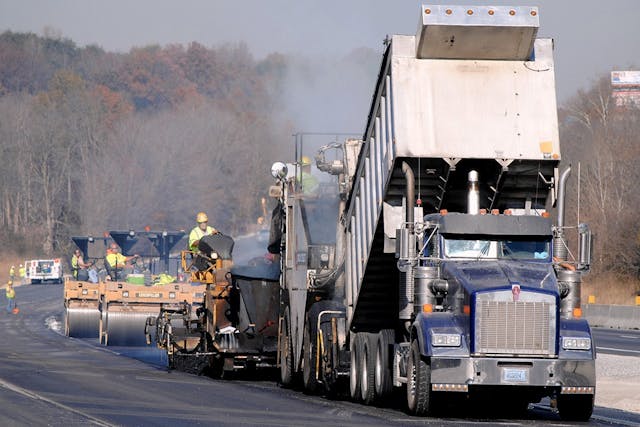Opening the Keys of Warm Mix Asphalt Technology
Exploring the depths of warm mix asphalt technology uncovers a globe where exact formulas and careful processes converge to form our roadways and infrastructure. The fusion of binders, fillers, and accumulations isn't just a building and construction job however a calculated orchestration of toughness and performance. As we peer right into the detailed dancing of components, a tapestry of resilience and sustainability unravels. Yet what exists below this surface area of asphaltic mastery, and what secrets wait to be unveiled in the world of leading technologies?
Significance of Warm Mix Asphalt
Hot Mix Asphalt plays a crucial function in modern facilities growth because of its longevity and cost-effectiveness. As the most generally used leading product for roads, freeways, and parking area, Warm Mix Asphalt offers a series of advantages that contribute to its relevance in construction jobs. One vital advantage is its capability to hold up against heavy web traffic tons and rough weather, giving a trusted and long-lasting surface for transport networks. In Addition, Warm Mix Asphalt is cost-effective in both initial building and long-lasting upkeep, making it a recommended selection for many infrastructure tasks.
The longevity of Hot Mix Asphalt stems from its composition, which consists of aggregates, binder, and filler products that are thoroughly selected and blended to meet details performance needs. In general, the importance of Warm Mix Asphalt in infrastructure development can not be understated, as it proceeds to be a cornerstone of contemporary construction methods.
Components of Asphalt Mixes
The structure of asphalt mixes contains meticulously chosen accumulations, binder, and filler materials that are vital for achieving certain performance demands. Accumulations are the primary element of asphalt blends, offering stamina and security. These aggregates can be natural, such as crushed rock or crushed stone, or artificial, like recycled products from old pavements. The binder, normally asphalt or asphalt cement, holds the aggregates with each other and provides flexibility and toughness to the mix. The selection of the binder is important as it straight affects the mix's performance in different climate condition. Fillers, such as moisturized lime or Rose city cement, are used to enhance the mix's workability and aging resistance. Angled Parking.
The mix and proportion of these elements play a substantial function in figuring out the high quality and efficiency of the asphalt mix. Engineers carefully make the mix to meet particular demands, taking into consideration aspects like website traffic volume, environment problems, and sidewalk life-span. Proper choice and balancing of aggregates, binder, and fillers are important for developing resilient, lasting asphalt sidewalks.
Combining and Manufacturing Strategies

As soon as the accumulations are picked, the binder, usually asphalt cement, is included to bind the materials with each other. The binder's high quality and amount dramatically impact the mix's resistance, flexibility, and toughness to environmental factors. Furthermore, fillers like hydrated lime or Portland concrete may be integrated to boost particular characteristics of the asphalt mix, such as its workability or dampness resistance.
During production, the aggregates and binder are warmed, commonly in between 250-325 ° F(121-163 ° C ), to assist in blending and make certain appropriate finishing of the accumulations. The mixing process must be detailed to accomplish a homogeneous blend that promotes the desired performance features of the asphalt. Various strategies, such as set blending or drum mixing, are used to achieve top notch and consistent asphalt blends for construction tasks.
Elements Influencing Asphalt Performance
Elements influencing asphalt performance incorporate a range of variables that impact the sturdiness, durability, and overall quality of asphalt sidewalks. One key element is the quality of materials utilized in the asphalt mix.

Layout factors to consider, such as pavement thickness and drainage, are vital in making sure the long-lasting efficiency of the asphalt sidewalk. By meticulously taking into consideration these factors, contractors and engineers can enhance asphalt performance and enhance the service life of sidewalks.
Lasting Practices in Asphalt Innovation

WMA allows for the production and positioning of asphalt mixes at lower temperature levels compared to conventional hot-mix asphalt, resulting in lowered energy usage and greenhouse gas exhausts. The use of permeable asphalt blends can help reduce stormwater runoff issues by allowing water to infiltrate with the pavement and into the ground, advertising all-natural pop over to this site water filtering and recharge procedures.
Verdict
To conclude, warm mix asphalt innovation plays a critical duty in modern-day framework development because of its toughness and cost-effectiveness. By carefully balancing components, utilizing proper mixing techniques, and considering numerous aspects, designers can produce high-grade asphalt blends that hold up against rush hour lots and extreme climate condition. Accepting sustainable practices, such as making use of warm-mix innovations and recycled materials, even more enhances the ecological kindness of asphalt innovation.
Mixing and manufacturing techniques in hot mix asphalt technology entail the click over here exact combination and handling of aggregates, binder, and fillers to create a sturdy and high-performance asphalt mix.Factors affecting asphalt performance encompass an array of variables that affect the resilience, long life, and general quality of asphalt sidewalks. Sustainable techniques in asphalt innovation encompass numerous initiatives intended at decreasing the ecological effect of asphalt manufacturing and paving processes. By including recovered asphalt sidewalk (RAP) and recycled asphalt roof shingles (RAS) right into new asphalt blends, the industry can dramatically minimize the consumption of raw materials and power, while also lowering landfill waste.
WMA enables for the production and placement of asphalt blends at lower temperature levels contrasted to conventional hot-mix asphalt, resulting in lowered energy usage and greenhouse gas exhausts.